Aviation Pricing and Revenue Management: Quiz Results and Comparison
VerifiedAdded on 2023/01/05
|6
|1272
|39
Report
AI Summary
This report on aviation pricing and revenue management begins with an analysis of quiz results, focusing on ancillary revenue, passenger income, and cost calculations (CASM). The analysis highlights the importance of balancing consumer demand (RPKs) with supply (ASKs) and the impact of business travelers on airline profitability. The report then compares two real-life airline companies, examining factors like seat configuration, loyalty programs, and the role of low-cost carriers. It discusses how airlines manage revenue through various strategies, including premium packages, frequent-flyer programs, and the impact of different airport locations. The report also touches on the impact of factors like stage duration and seating configuration on costs, and the importance of adapting to changing travel patterns, such as the shift towards remote work and the use of retail and corporate credit cards. The report is supported by references to relevant academic sources.
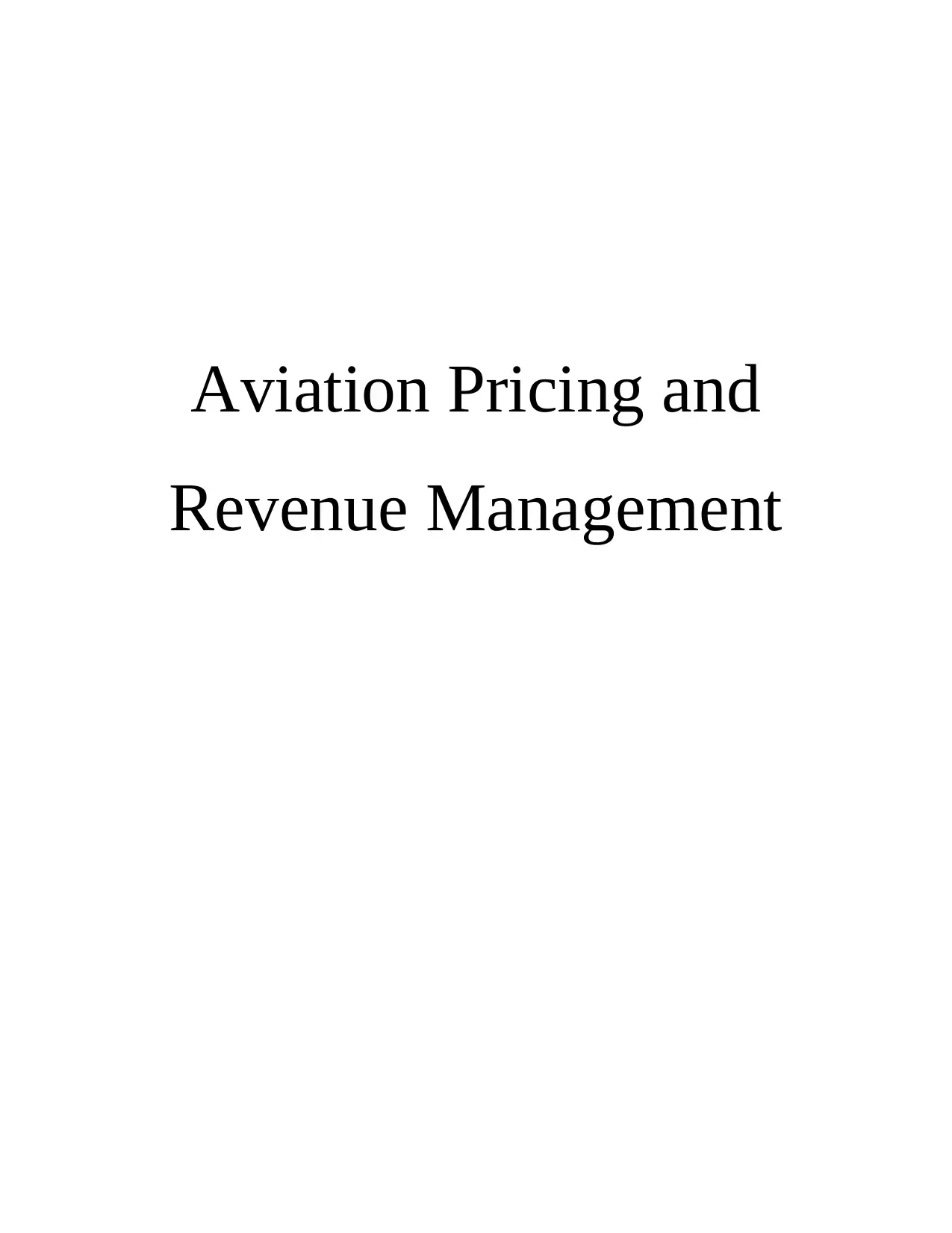
Aviation Pricing and
Revenue Management
Revenue Management
Paraphrase This Document
Need a fresh take? Get an instant paraphrase of this document with our AI Paraphraser
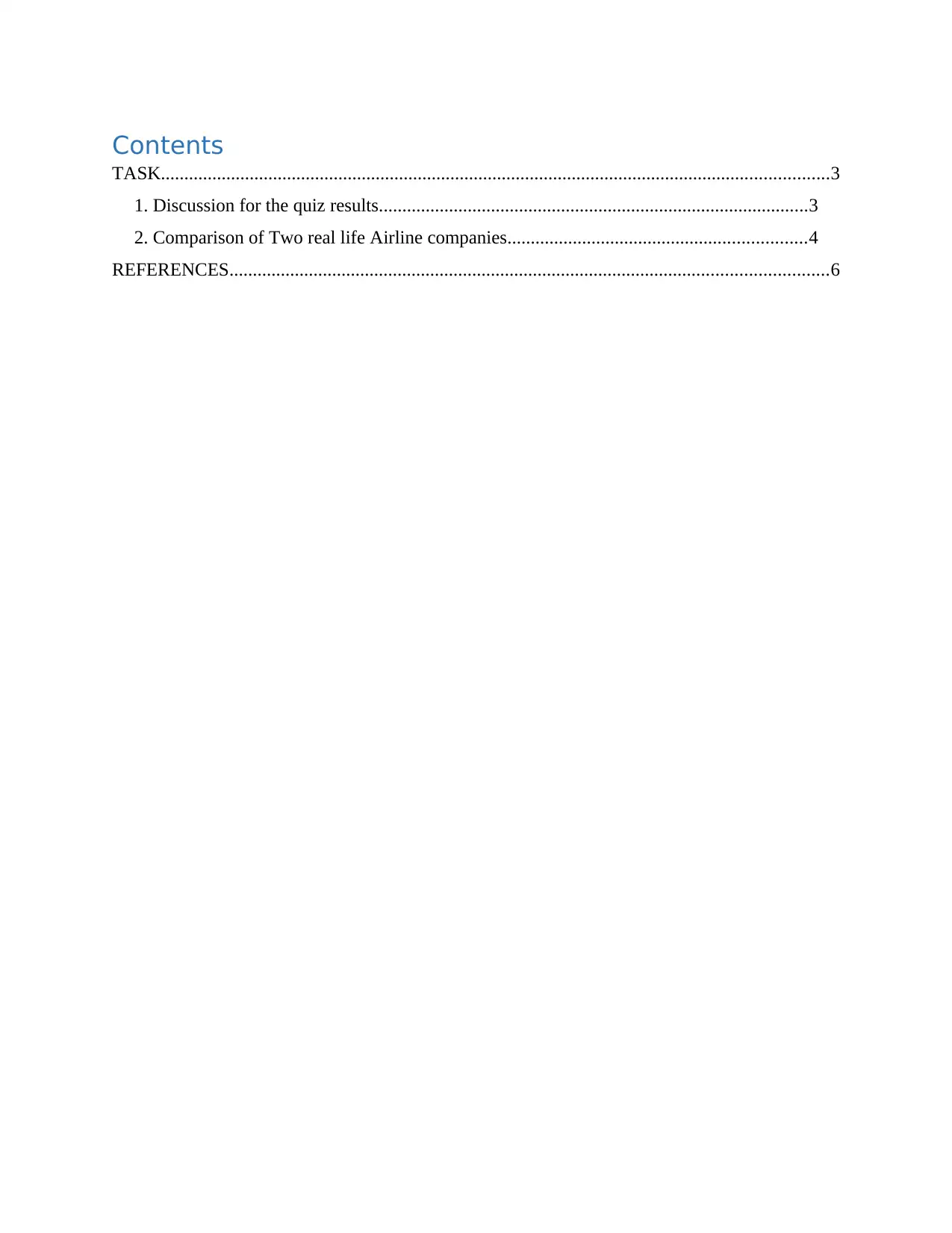
Contents
TASK...............................................................................................................................................3
1. Discussion for the quiz results............................................................................................3
2. Comparison of Two real life Airline companies................................................................4
REFERENCES................................................................................................................................6
TASK...............................................................................................................................................3
1. Discussion for the quiz results............................................................................................3
2. Comparison of Two real life Airline companies................................................................4
REFERENCES................................................................................................................................6
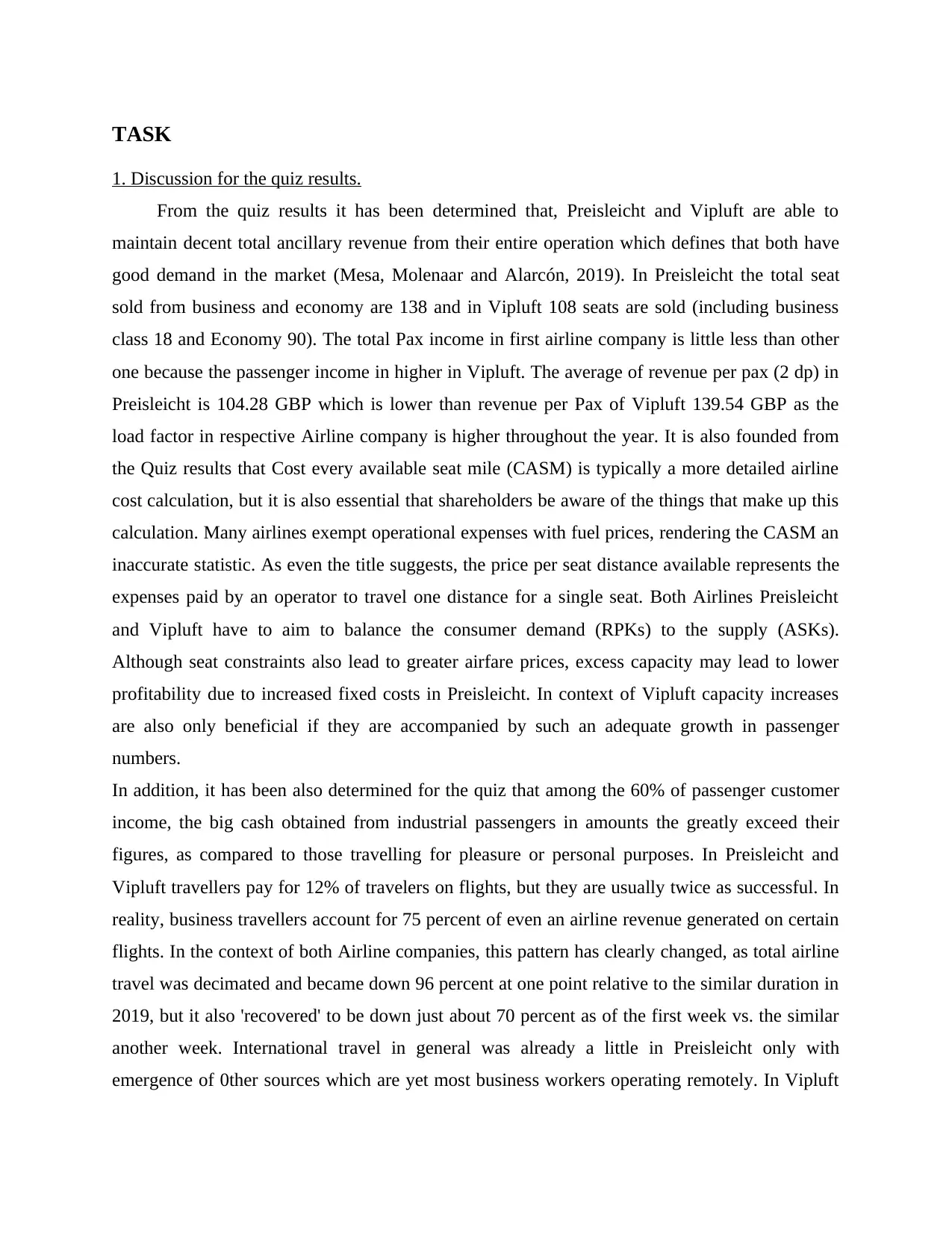
TASK
1. Discussion for the quiz results.
From the quiz results it has been determined that, Preisleicht and Vipluft are able to
maintain decent total ancillary revenue from their entire operation which defines that both have
good demand in the market (Mesa, Molenaar and Alarcón, 2019). In Preisleicht the total seat
sold from business and economy are 138 and in Vipluft 108 seats are sold (including business
class 18 and Economy 90). The total Pax income in first airline company is little less than other
one because the passenger income in higher in Vipluft. The average of revenue per pax (2 dp) in
Preisleicht is 104.28 GBP which is lower than revenue per Pax of Vipluft 139.54 GBP as the
load factor in respective Airline company is higher throughout the year. It is also founded from
the Quiz results that Cost every available seat mile (CASM) is typically a more detailed airline
cost calculation, but it is also essential that shareholders be aware of the things that make up this
calculation. Many airlines exempt operational expenses with fuel prices, rendering the CASM an
inaccurate statistic. As even the title suggests, the price per seat distance available represents the
expenses paid by an operator to travel one distance for a single seat. Both Airlines Preisleicht
and Vipluft have to aim to balance the consumer demand (RPKs) to the supply (ASKs).
Although seat constraints also lead to greater airfare prices, excess capacity may lead to lower
profitability due to increased fixed costs in Preisleicht. In context of Vipluft capacity increases
are also only beneficial if they are accompanied by such an adequate growth in passenger
numbers.
In addition, it has been also determined for the quiz that among the 60% of passenger customer
income, the big cash obtained from industrial passengers in amounts the greatly exceed their
figures, as compared to those travelling for pleasure or personal purposes. In Preisleicht and
Vipluft travellers pay for 12% of travelers on flights, but they are usually twice as successful. In
reality, business travellers account for 75 percent of even an airline revenue generated on certain
flights. In the context of both Airline companies, this pattern has clearly changed, as total airline
travel was decimated and became down 96 percent at one point relative to the similar duration in
2019, but it also 'recovered' to be down just about 70 percent as of the first week vs. the similar
another week. International travel in general was already a little in Preisleicht only with
emergence of 0ther sources which are yet most business workers operating remotely. In Vipluft
1. Discussion for the quiz results.
From the quiz results it has been determined that, Preisleicht and Vipluft are able to
maintain decent total ancillary revenue from their entire operation which defines that both have
good demand in the market (Mesa, Molenaar and Alarcón, 2019). In Preisleicht the total seat
sold from business and economy are 138 and in Vipluft 108 seats are sold (including business
class 18 and Economy 90). The total Pax income in first airline company is little less than other
one because the passenger income in higher in Vipluft. The average of revenue per pax (2 dp) in
Preisleicht is 104.28 GBP which is lower than revenue per Pax of Vipluft 139.54 GBP as the
load factor in respective Airline company is higher throughout the year. It is also founded from
the Quiz results that Cost every available seat mile (CASM) is typically a more detailed airline
cost calculation, but it is also essential that shareholders be aware of the things that make up this
calculation. Many airlines exempt operational expenses with fuel prices, rendering the CASM an
inaccurate statistic. As even the title suggests, the price per seat distance available represents the
expenses paid by an operator to travel one distance for a single seat. Both Airlines Preisleicht
and Vipluft have to aim to balance the consumer demand (RPKs) to the supply (ASKs).
Although seat constraints also lead to greater airfare prices, excess capacity may lead to lower
profitability due to increased fixed costs in Preisleicht. In context of Vipluft capacity increases
are also only beneficial if they are accompanied by such an adequate growth in passenger
numbers.
In addition, it has been also determined for the quiz that among the 60% of passenger customer
income, the big cash obtained from industrial passengers in amounts the greatly exceed their
figures, as compared to those travelling for pleasure or personal purposes. In Preisleicht and
Vipluft travellers pay for 12% of travelers on flights, but they are usually twice as successful. In
reality, business travellers account for 75 percent of even an airline revenue generated on certain
flights. In the context of both Airline companies, this pattern has clearly changed, as total airline
travel was decimated and became down 96 percent at one point relative to the similar duration in
2019, but it also 'recovered' to be down just about 70 percent as of the first week vs. the similar
another week. International travel in general was already a little in Preisleicht only with
emergence of 0ther sources which are yet most business workers operating remotely. In Vipluft
⊘ This is a preview!⊘
Do you want full access?
Subscribe today to unlock all pages.

Trusted by 1+ million students worldwide
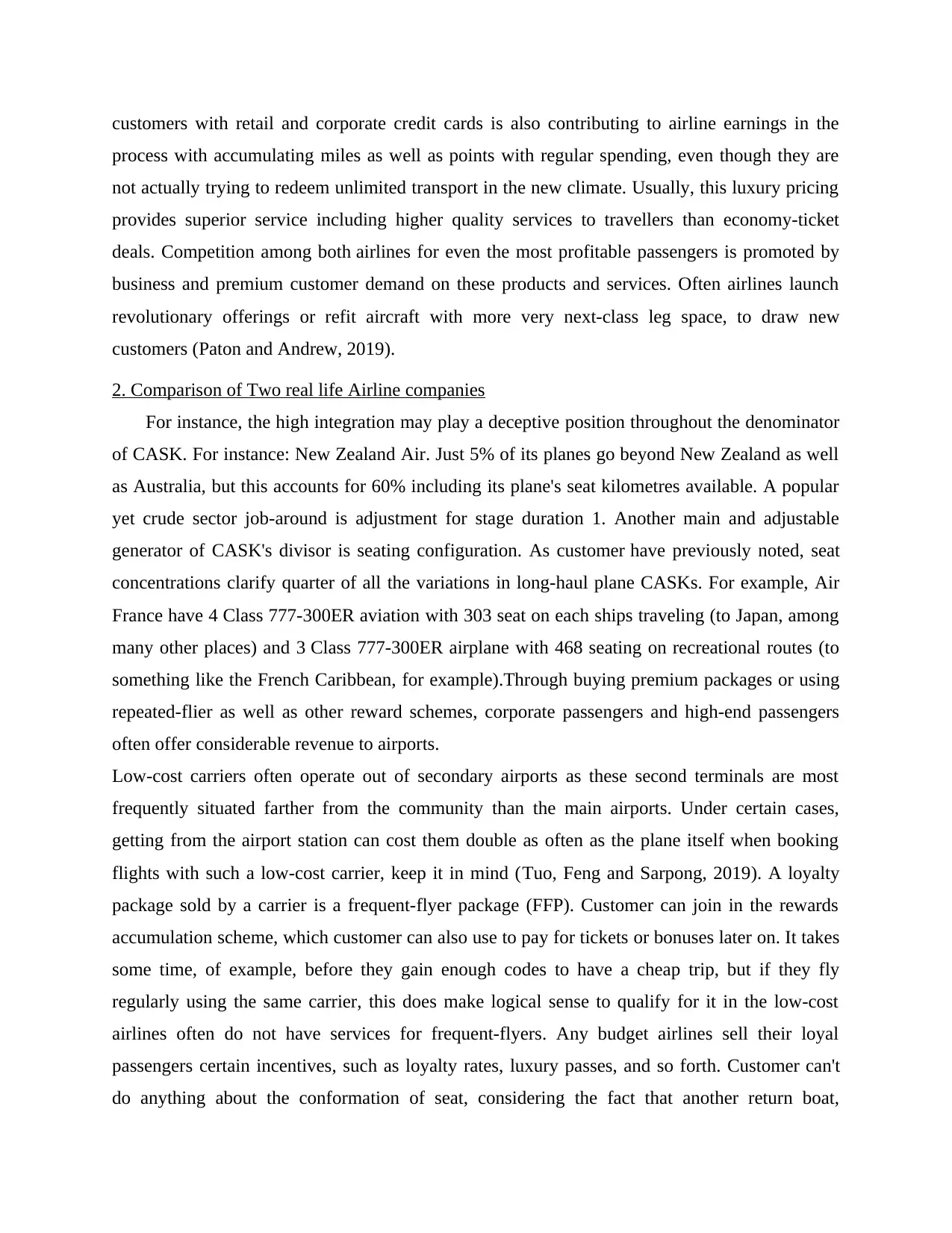
customers with retail and corporate credit cards is also contributing to airline earnings in the
process with accumulating miles as well as points with regular spending, even though they are
not actually trying to redeem unlimited transport in the new climate. Usually, this luxury pricing
provides superior service including higher quality services to travellers than economy-ticket
deals. Competition among both airlines for even the most profitable passengers is promoted by
business and premium customer demand on these products and services. Often airlines launch
revolutionary offerings or refit aircraft with more very next-class leg space, to draw new
customers (Paton and Andrew, 2019).
2. Comparison of Two real life Airline companies
For instance, the high integration may play a deceptive position throughout the denominator
of CASK. For instance: New Zealand Air. Just 5% of its planes go beyond New Zealand as well
as Australia, but this accounts for 60% including its plane's seat kilometres available. A popular
yet crude sector job-around is adjustment for stage duration 1. Another main and adjustable
generator of CASK's divisor is seating configuration. As customer have previously noted, seat
concentrations clarify quarter of all the variations in long-haul plane CASKs. For example, Air
France have 4 Class 777-300ER aviation with 303 seat on each ships traveling (to Japan, among
many other places) and 3 Class 777-300ER airplane with 468 seating on recreational routes (to
something like the French Caribbean, for example).Through buying premium packages or using
repeated-flier as well as other reward schemes, corporate passengers and high-end passengers
often offer considerable revenue to airports.
Low-cost carriers often operate out of secondary airports as these second terminals are most
frequently situated farther from the community than the main airports. Under certain cases,
getting from the airport station can cost them double as often as the plane itself when booking
flights with such a low-cost carrier, keep it in mind (Tuo, Feng and Sarpong, 2019). A loyalty
package sold by a carrier is a frequent-flyer package (FFP). Customer can join in the rewards
accumulation scheme, which customer can also use to pay for tickets or bonuses later on. It takes
some time, of example, before they gain enough codes to have a cheap trip, but if they fly
regularly using the same carrier, this does make logical sense to qualify for it in the low-cost
airlines often do not have services for frequent-flyers. Any budget airlines sell their loyal
passengers certain incentives, such as loyalty rates, luxury passes, and so forth. Customer can't
do anything about the conformation of seat, considering the fact that another return boat,
process with accumulating miles as well as points with regular spending, even though they are
not actually trying to redeem unlimited transport in the new climate. Usually, this luxury pricing
provides superior service including higher quality services to travellers than economy-ticket
deals. Competition among both airlines for even the most profitable passengers is promoted by
business and premium customer demand on these products and services. Often airlines launch
revolutionary offerings or refit aircraft with more very next-class leg space, to draw new
customers (Paton and Andrew, 2019).
2. Comparison of Two real life Airline companies
For instance, the high integration may play a deceptive position throughout the denominator
of CASK. For instance: New Zealand Air. Just 5% of its planes go beyond New Zealand as well
as Australia, but this accounts for 60% including its plane's seat kilometres available. A popular
yet crude sector job-around is adjustment for stage duration 1. Another main and adjustable
generator of CASK's divisor is seating configuration. As customer have previously noted, seat
concentrations clarify quarter of all the variations in long-haul plane CASKs. For example, Air
France have 4 Class 777-300ER aviation with 303 seat on each ships traveling (to Japan, among
many other places) and 3 Class 777-300ER airplane with 468 seating on recreational routes (to
something like the French Caribbean, for example).Through buying premium packages or using
repeated-flier as well as other reward schemes, corporate passengers and high-end passengers
often offer considerable revenue to airports.
Low-cost carriers often operate out of secondary airports as these second terminals are most
frequently situated farther from the community than the main airports. Under certain cases,
getting from the airport station can cost them double as often as the plane itself when booking
flights with such a low-cost carrier, keep it in mind (Tuo, Feng and Sarpong, 2019). A loyalty
package sold by a carrier is a frequent-flyer package (FFP). Customer can join in the rewards
accumulation scheme, which customer can also use to pay for tickets or bonuses later on. It takes
some time, of example, before they gain enough codes to have a cheap trip, but if they fly
regularly using the same carrier, this does make logical sense to qualify for it in the low-cost
airlines often do not have services for frequent-flyers. Any budget airlines sell their loyal
passengers certain incentives, such as loyalty rates, luxury passes, and so forth. Customer can't
do anything about the conformation of seat, considering the fact that another return boat,
Paraphrase This Document
Need a fresh take? Get an instant paraphrase of this document with our AI Paraphraser
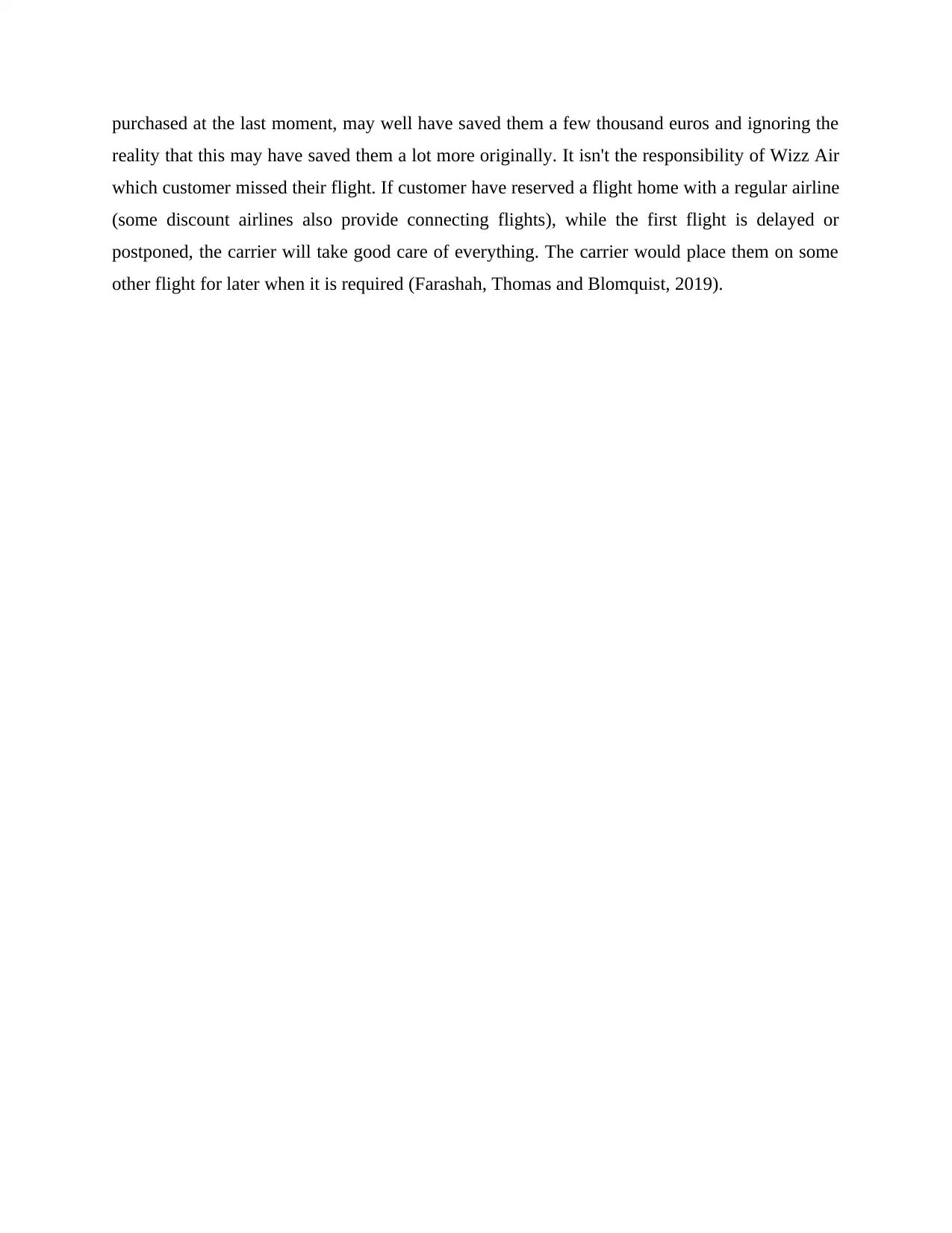
purchased at the last moment, may well have saved them a few thousand euros and ignoring the
reality that this may have saved them a lot more originally. It isn't the responsibility of Wizz Air
which customer missed their flight. If customer have reserved a flight home with a regular airline
(some discount airlines also provide connecting flights), while the first flight is delayed or
postponed, the carrier will take good care of everything. The carrier would place them on some
other flight for later when it is required (Farashah, Thomas and Blomquist, 2019).
reality that this may have saved them a lot more originally. It isn't the responsibility of Wizz Air
which customer missed their flight. If customer have reserved a flight home with a regular airline
(some discount airlines also provide connecting flights), while the first flight is delayed or
postponed, the carrier will take good care of everything. The carrier would place them on some
other flight for later when it is required (Farashah, Thomas and Blomquist, 2019).
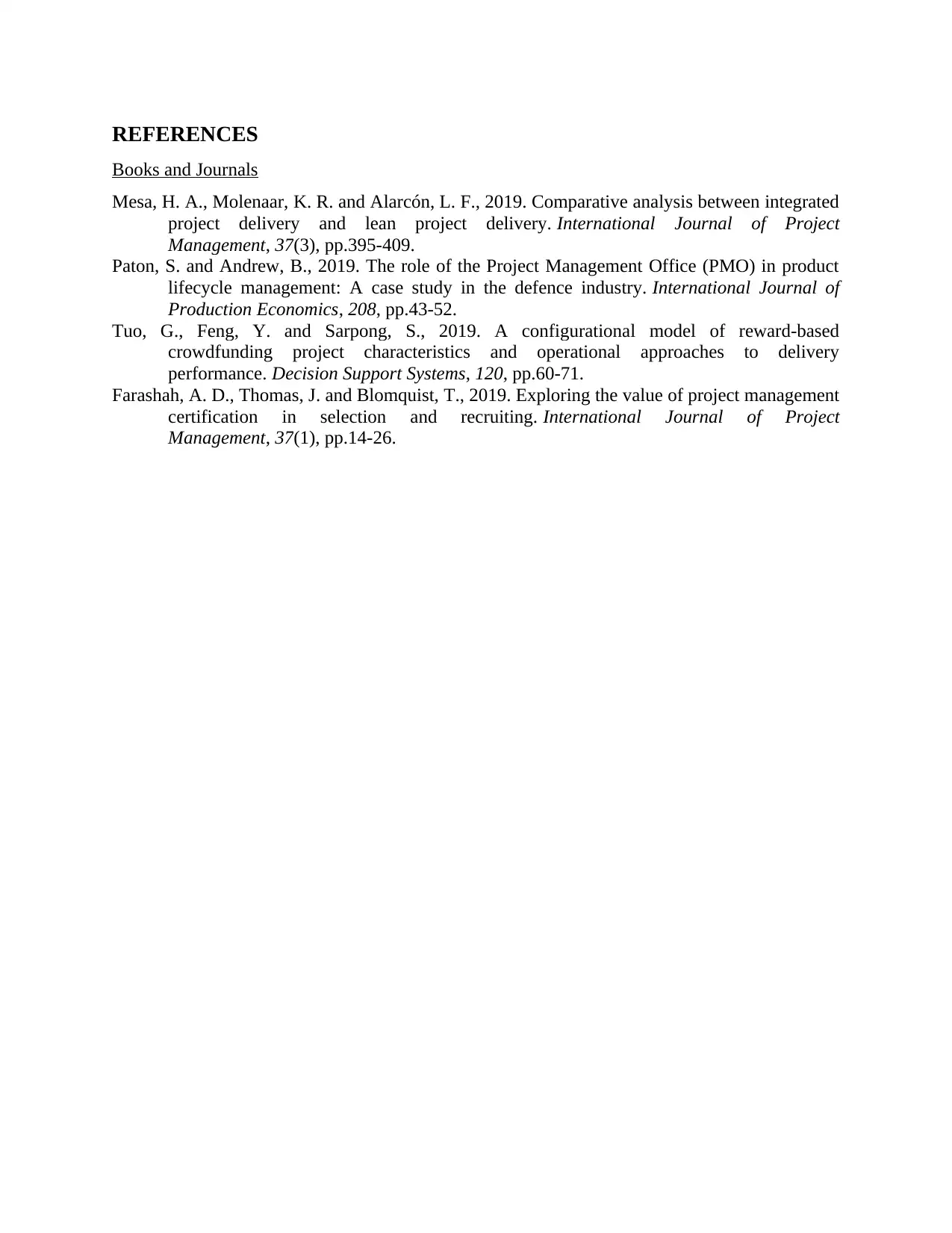
REFERENCES
Books and Journals
Mesa, H. A., Molenaar, K. R. and Alarcón, L. F., 2019. Comparative analysis between integrated
project delivery and lean project delivery. International Journal of Project
Management, 37(3), pp.395-409.
Paton, S. and Andrew, B., 2019. The role of the Project Management Office (PMO) in product
lifecycle management: A case study in the defence industry. International Journal of
Production Economics, 208, pp.43-52.
Tuo, G., Feng, Y. and Sarpong, S., 2019. A configurational model of reward-based
crowdfunding project characteristics and operational approaches to delivery
performance. Decision Support Systems, 120, pp.60-71.
Farashah, A. D., Thomas, J. and Blomquist, T., 2019. Exploring the value of project management
certification in selection and recruiting. International Journal of Project
Management, 37(1), pp.14-26.
Books and Journals
Mesa, H. A., Molenaar, K. R. and Alarcón, L. F., 2019. Comparative analysis between integrated
project delivery and lean project delivery. International Journal of Project
Management, 37(3), pp.395-409.
Paton, S. and Andrew, B., 2019. The role of the Project Management Office (PMO) in product
lifecycle management: A case study in the defence industry. International Journal of
Production Economics, 208, pp.43-52.
Tuo, G., Feng, Y. and Sarpong, S., 2019. A configurational model of reward-based
crowdfunding project characteristics and operational approaches to delivery
performance. Decision Support Systems, 120, pp.60-71.
Farashah, A. D., Thomas, J. and Blomquist, T., 2019. Exploring the value of project management
certification in selection and recruiting. International Journal of Project
Management, 37(1), pp.14-26.
⊘ This is a preview!⊘
Do you want full access?
Subscribe today to unlock all pages.

Trusted by 1+ million students worldwide
1 out of 6
Related Documents
Your All-in-One AI-Powered Toolkit for Academic Success.
+13062052269
info@desklib.com
Available 24*7 on WhatsApp / Email
![[object Object]](/_next/static/media/star-bottom.7253800d.svg)
Unlock your academic potential
Copyright © 2020–2025 A2Z Services. All Rights Reserved. Developed and managed by ZUCOL.





